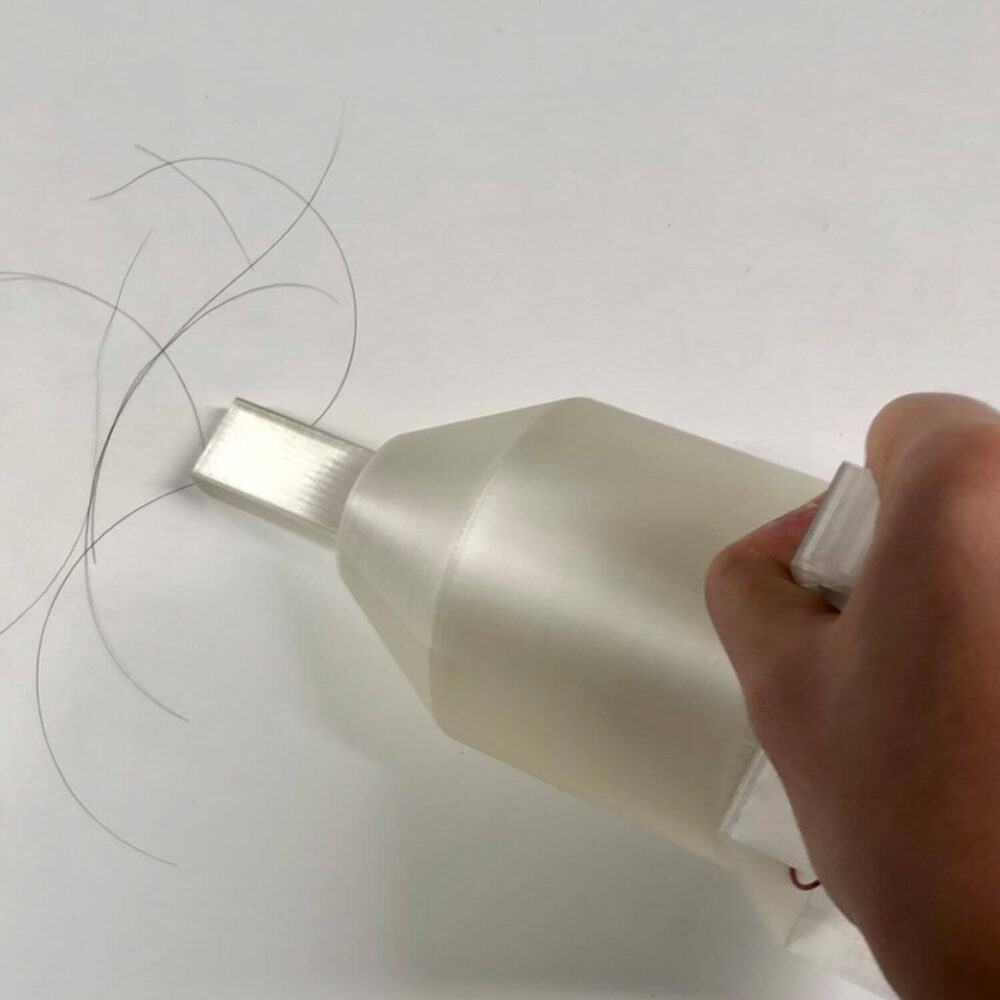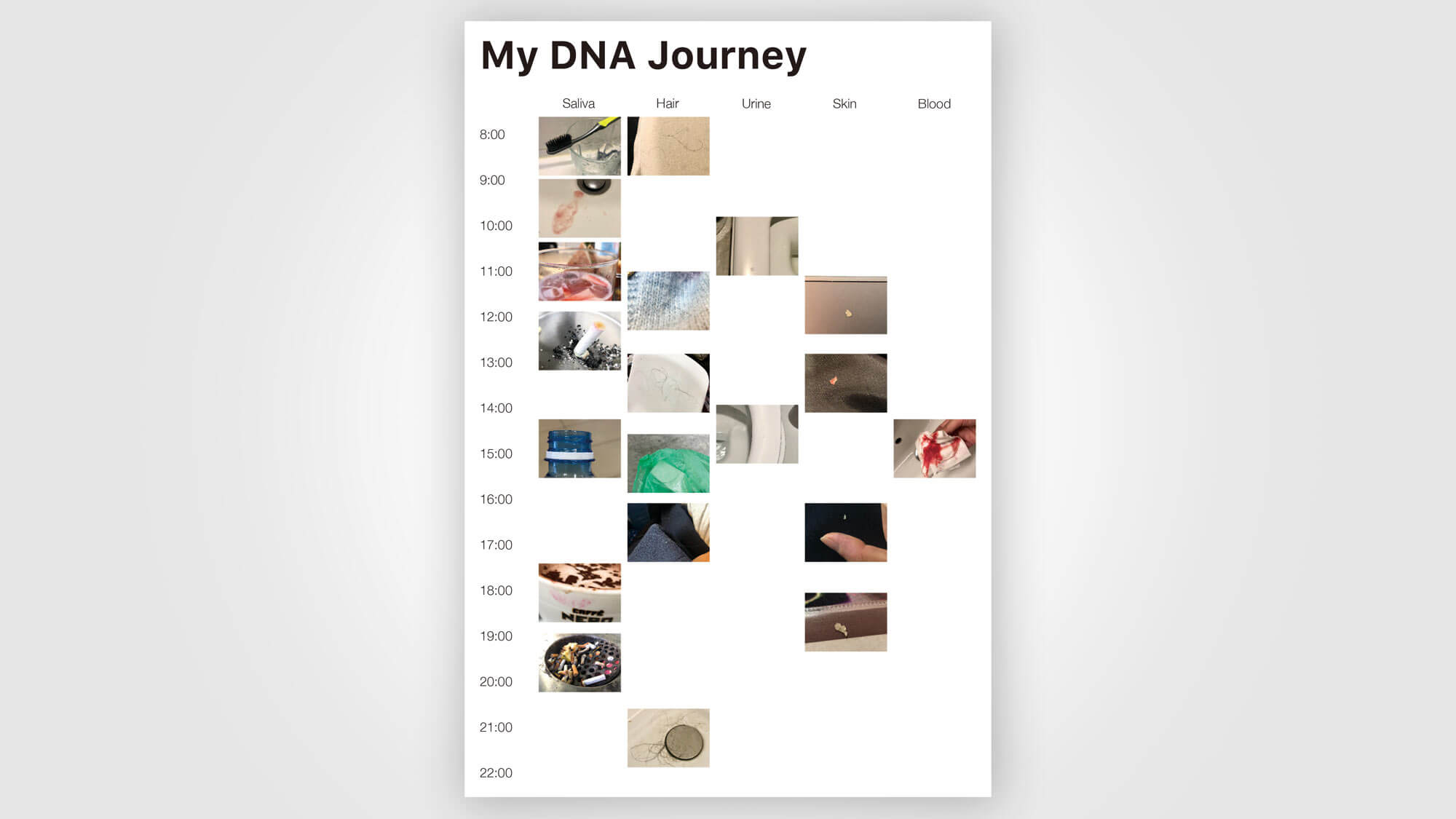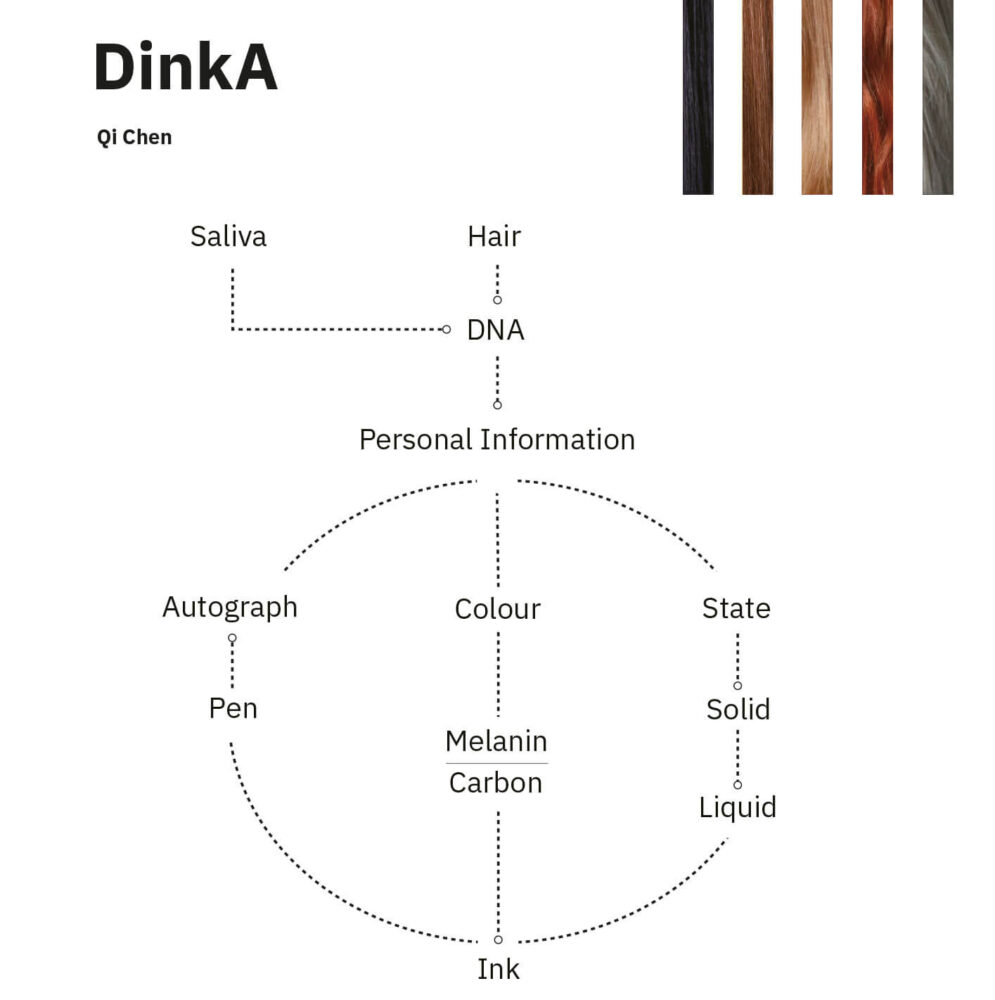

DinkA
by
Qi Chen
Concept
The results of my research during the FOUNDING LAB Fall Term program are a series of tools for collecting genetic fragments and a DNA ink for authentication using human genetic fragments. I recorded all the genetic traces that could be left behind, such as saliva, hair, skin, urine, blood, etc., and used these genetic traces to enhance our identity. Hair and saliva were the easiest and most widely left behind. It was the start of a genetic series of projects. I made ink by mixing DNA extracted from saliva with melanin extracted from hair and blending the tangible and genetic dimensions of identity condensed into a signature stroke.
By sending out adverts, many people have expressed interest for volunteers to donate saliva and hair samples on social media platforms as well as in my moments. However, there is always some bias in the collection process. Therefore, I designed tools to collect hair and saliva samples. Inspired by the design idea of the Japanese Chindōgu1, the solution I came up with was that it would be interesting to use a portable device that automatically sucks up the hair. So, I started experimenting with a Dyson Hoover and kept iterating the device’s design.
For the Bio Art experiment, I learned about biology and got technical support from Biolab. Starting from how to calculate the volume of reagents, then trying to extract DNA from saliva with detergent and salt at home to understand the principles involved, and then to professional equipment, I modified my experimental protocol many times. However, I also experienced many failures during the experiments. When extracting melanin from hair, I first used the method of extracting melanin with acid and alkali, and the obtained melanin yield needed to be higher. The acid and alkali damaged the structure. Then, I tried to extract it with the enzyme method. I need to look further into whether users can use DNA ink for authentication.
After realizing the personal experiment, I also explored whether users of different race and cultural backgrounds psychologically accepted and used their DNA ink. Some expressed that it was exciting, that they would like to have their own DNA ink, and that perhaps writing with it would make them more accountable for their words and actions. A few also said it makes you feel creepy when you receive someone else’s writing in DNA ink.
The project demonstrates the fusion of art, science, and technology; through DNA ink, I have created a novel medium of artistic expression, this transcendent expression not only weaves the narrative of my life but also explores the creation of a novel and intriguing intersection between biological identity and self-expression. In the hair-collecting installation, I propose a new method of harvesting genetic material, demonstrating how the field of bio-art makes innovative use of engineering techniques. Beyond this, the project raises questions about informed consent, privacy, and the responsible handling of sensitive genetic data. The exploration of the use of DNA ink for authentication introduces new applications of genetic information and opens up discussions about the intersection of genetics, identity, and security.
Process Reflection
The project was inspired by my personal experience when I was stressed at work, and I noticed my hair falling out everywhere. I began to observe its color, quantity, length, and where it fell. It has a narrative quality, recording the trajectory of my life, reflecting my state of being, my physical condition, and all sorts of other information. At the same time, it means that I leave genetic traces everywhere. Could this genetic information be interestingly encoded and decoded? Therefore, my initial concept was to extract DNA and melanin from the hair into a unique ink and develop and utilize it for identification and authentication.
The original experimental protocol was to extract DNA from hair with hair follicles and melanin from the hair shaft portion of the hair, thus mixing and making the ink. During the experiment, I assumed that if the melanin in the dissolved hair contained DNA, then I would not need to extract the DNA separately and only need to verify that the words written in the ink contained DNA. However, with the technical support of Biolab, I quickly disproved the hypothesis. Because the DNA extracted from hair is only a DNA fragment, I cannot use the ink-mixed melanin for authentication.
Since then, I haven’t just focused on hair and have recorded all the traces of DNA that can be left behind, including saliva, fingernails, dander, and more. I expanded this project into a series that utilizes these genetic fragments left behind to enhance our identity. I found that hair and saliva were the most accessible and most widely left behind; most importantly, saliva had the complete DNA sequence. Therefore, my program changed to extracting DNA from saliva and mixing it with melanin from hair as an ink.
At home, I have studied the extraction of DNA from saliva using pineapple juice, washing up liquid, salt, and alcohol. Pineapple juice containing bromelain acts as a protein hydrolyzer to rupture cell membranes and washing up liquid is a detergent to break down cell walls and expose DNA. Add a small amount of salt, which acts as a flocculant to make the cells‘ contents stick together. Add a small amount of salt, which acts as a flocculant to make the cells‘ contents stick together.
Extracting melanin from hair requires removing 65-95% of the hair protein, which can then be separated from the melanin by acid-base and enzymatic methods. Initially, I used the easier-to-achieve acid-base method, but the results could have been more satisfactory. Acid/base extraction not only changes the structure of the melanin molecule but also destroys the structure of the DNA if it is mixed with it. In contrast, enzymatic extraction of melanin retained the morphology of intact melanosomes.
Interdisciplinarity played a vital role in the project, bridging different fields such as biology, art, genetics, and technology. The project originated as a personal experience and evolved into a multifaceted exploration that required interdisciplinary collaboration. It integrated the biology of extracting DNA, the chemistry of extracting melanin, the art of creating DNA ink, and the hair collection installation technology. The collaboration with the Biological Laboratory exemplifies the importance of interdisciplinary collaboration, as technical support from biologists helps increase the project’s scientific rigor.
I think the new university could be strengthened by fostering collaboration between the biology, art, and engineering departments and could include the project as part of the Bio Art program. Design collaborative spaces that bring scientists, artists, and technologists together. Develop a public engagement program to provide public awareness and understanding of bio art. Exhibitions and lectures could demonstrate the potential of bio art and encourage dialogue between the university community and the wider public.




